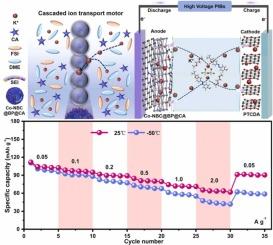为高能量和快速充电的钾离子电池定制黑磷纳米结构:化学物理/电化学设计策略
IF 17.1
1区 材料科学
Q1 CHEMISTRY, PHYSICAL
引用次数: 0
摘要
在使用黑磷(BP)的钾离子电池(PIBs)中追求高能量密度和快速充电一直受到其固有挑战的阻碍,包括低电压输出和缓慢的离子传输动力学。为了克服这些限制,精心设计的超薄BP纳米结构,配备了精确的吸附阀控制器和定向结晶,被封装在含有Co单原子/纳米团簇(Co- nbc)的N, B共掺杂碳纳米球中。这种封装被(E)-2-氯-4-((3 ' -氯-4 ' -羟基苯基)二嗪基)苯基丙烯酸酯(CA)进一步强化,从而形成一种结构,提供了一个扩展的电压窗口和增强的级联离子传输、界面和阳极。Co-NBC@BP@CA结构具有高能量密度、3.36 V的电化学稳定窗(ESW)、−55-0 °C的低温适应性等优异的性能。这是由于强大的F/O相互作用和重建的氢键。这种创新的化学物理/电化学设计策略不仅提高了基于bp的PIBs的性能,而且揭示了自旋轨道耦合和级联离子输运在高能PIBs发展中的关键作用。这一进展为该领域的进一步研究和开发开辟了新的途径,有可能导致创造更有效和可持续的能源存储解决方案。本文章由计算机程序翻译,如有差异,请以英文原文为准。

Tailoring black phosphorus nanostructures for high-energy and fast-charging potassium ion batteries: A chemicophysical/electrochemical design strategy
The quest for high energy density and rapid charging in potassium ion batteries (PIBs) employing black phosphorus (BP) has been hindered by its inherent challenges, including low voltage output and sluggish ion transport kinetics. To overcome these limitations, a meticulously engineered ultrathin BP nanostructure, equipped with a precise adsorption valve controller and an oriented crystallization, is encapsulated within N, B co-doped carbon nanospheres that contain Co single atoms/nanoclusters (Co-NBC). This encapsulation is further fortified by (E)-2-chloro-4-((3’-chloro-4’-hydroxyphenyl)diazinyl)phenyl acrylate (CA), resulting in a structure that offers an extended voltage window and enhanced cascaded ion transport, interface, and anode. The Co-NBC@BP@CA structure demonstrates remarkable performance, boasting high energy density, high electrochemical stable window (ESW) of 3.36 V, and impressive low-temperature adaptability ranging from −55–0 °C. These are attributed to the robust F/O interactions and the reconstructed hydrogen bonds. This innovative chemicophysical/electrochemical design strategy not only enhances the performance of BP-based PIBs but also sheds light on the pivotal roles of spin-orbit coupling and cascaded ion transport in the development of high-energy PIBs. This advancement opens up new avenues for further research and development in the field, potentially leading to the creation of more efficient and sustainable energy storage solutions.
求助全文
通过发布文献求助,成功后即可免费获取论文全文。
去求助
来源期刊

Nano Energy
CHEMISTRY, PHYSICAL-NANOSCIENCE & NANOTECHNOLOGY
CiteScore
30.30
自引率
7.40%
发文量
1207
审稿时长
23 days
期刊介绍:
Nano Energy is a multidisciplinary, rapid-publication forum of original peer-reviewed contributions on the science and engineering of nanomaterials and nanodevices used in all forms of energy harvesting, conversion, storage, utilization and policy. Through its mixture of articles, reviews, communications, research news, and information on key developments, Nano Energy provides a comprehensive coverage of this exciting and dynamic field which joins nanoscience and nanotechnology with energy science. The journal is relevant to all those who are interested in nanomaterials solutions to the energy problem.
Nano Energy publishes original experimental and theoretical research on all aspects of energy-related research which utilizes nanomaterials and nanotechnology. Manuscripts of four types are considered: review articles which inform readers of the latest research and advances in energy science; rapid communications which feature exciting research breakthroughs in the field; full-length articles which report comprehensive research developments; and news and opinions which comment on topical issues or express views on the developments in related fields.
 求助内容:
求助内容: 应助结果提醒方式:
应助结果提醒方式:


